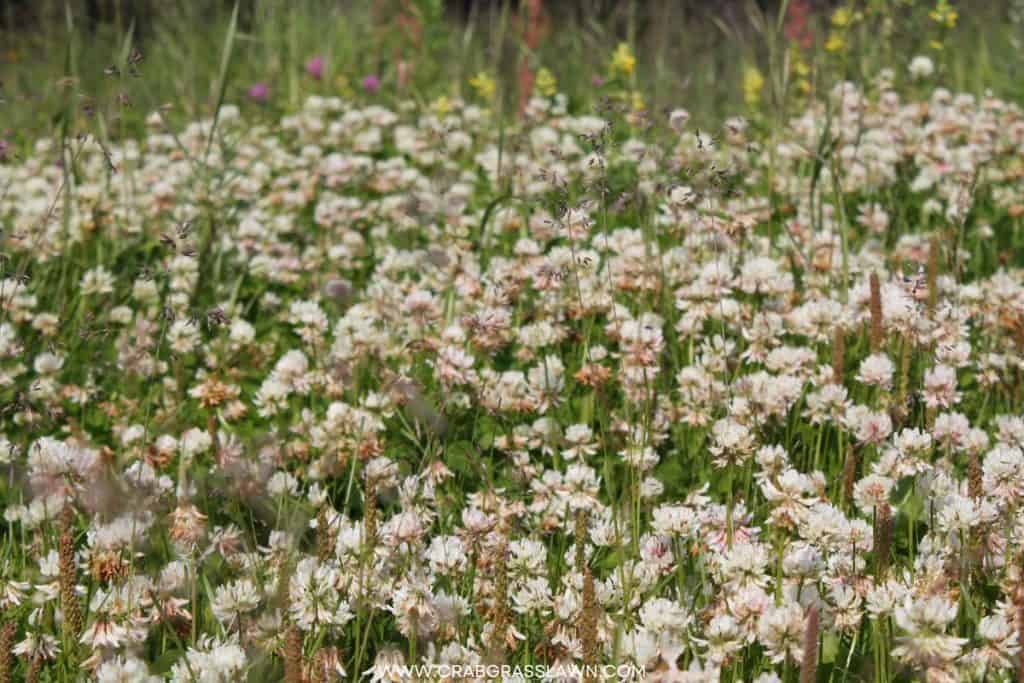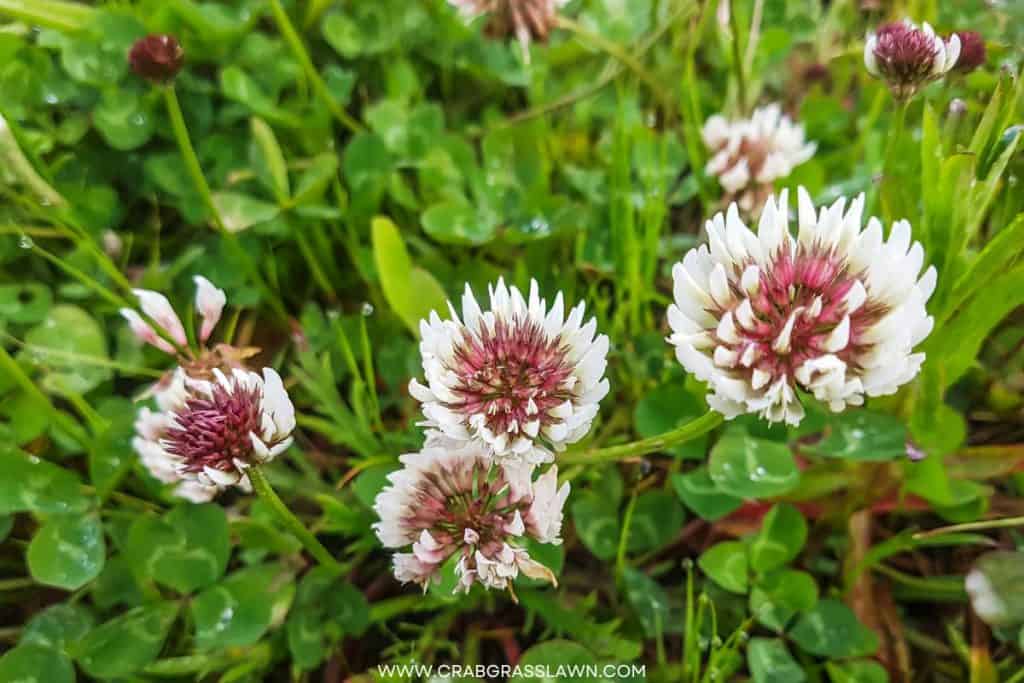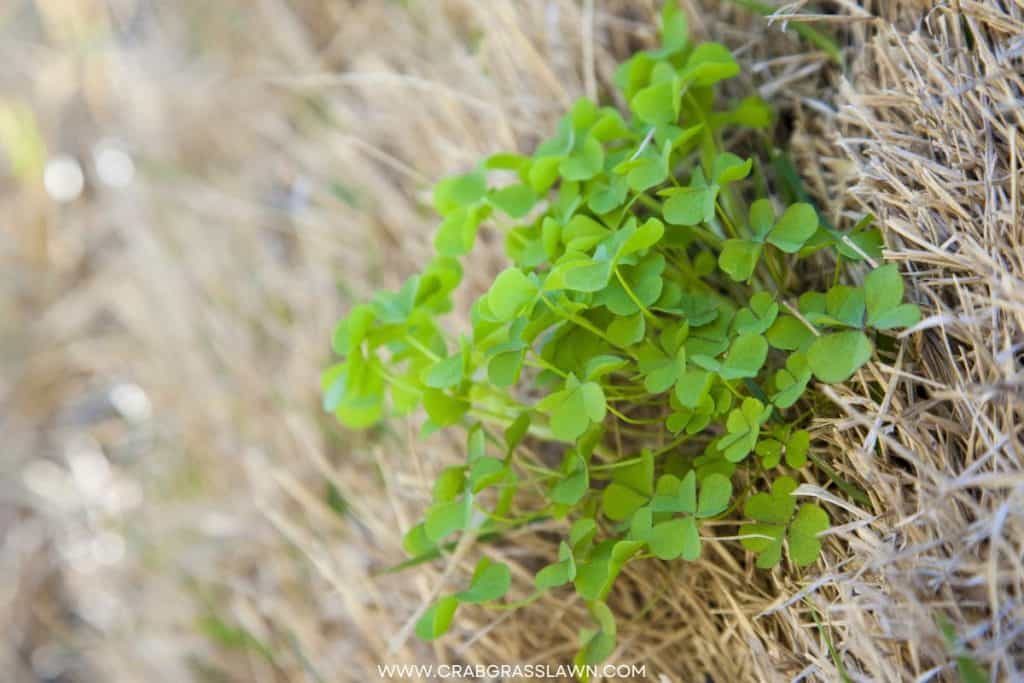Trying to find ways to grow a healthy lawn but free up time spent on lawn care? Have you been thinking about growing a Dutch white clover lawn? Well, you’re not alone!
Clover offers some fantastic benefits to homeowners, and Dutch white clover is increasing in popularity as a lower-maintenance, environmentally-conscious lawn replacement.
Depending upon your lawn needs and personal preferences, you can plant white Dutch clover with standard lawn grasses or opt for solid Dutch clover instead of grass. You’ll find yourself admiring a deep green lawn that doesn’t need much water, weed killer, or fertilizer. Plus, you won’t tie up your Saturday morning mowing.
In this article, I’ll cover what Dutch white clover is, why you should grow it, step-by-step instructions on planting, and general care information. Everything you need to know to get started and successfully grow a Dutch white clover lawn!
What Is Dutch White Clover?
Dutch white clover (Trifolium repens)—also known as Dutch clover, Dutch white, or white clover—is the most well-known type of clover in the United States.
It’s a highly versatile cool-season (prefers cooler daytime temperatures compared to warmer temps), herbaceous (lacks a woody stem) perennial (lives more than two years) with both agricultural and horticultural uses.
Dutch white is commonly utilized in lawns and pasture mixtures. It is also grown for erosion control, food plots, ground cover, green manure, and often as a cover crop.

Dutch White Clover in American Lawns
A hundred years ago, white Dutch clover was a common component in lawn seed mixes, hence was found in yards across the country. In the 1950s—when herbicides took off in popularity—the mindset of homeowners changed. The goal became well-manicured, weed-free lawns, and clovers became a nuisance plant that wasn’t accepted in traditional grass lawns.
As homeowners are looking for low-maintenance or environmentally-conscious lawn alternatives, Dutch clover is making its way back into yards as entire lawns or a mixed lawn with clover.
Common Dutch White Clover Characteristics
- Grows 4 to 8” tall when fully mature.
- Shamrock-shaped leaves.
- Produces whitish-pink or white flowers.
- Needs 4 to 6 hours of sun daily.
- Thrives in poor or rocky soils.
- Efficiently suppresses weed growth.
- Stays green all year where winters aren’t too cold.
- Turns atmospheric nitrogen into a usable plant form.

Pros and Cons of a Dutch White Clover Lawn
15 Benefits of a Dutch White Clover Lawn
- Uses less water. Clover roots grow deep into the soil, accessing more water and helping plants become drought-tolerant.
- Doesn’t need mowing. Clover grows shorter than a traditional lawn and doesn’t need to be mowed unless you want to knock off the flowers or keep them from going to seed.
- Grows in poor soil. Clover doesn’t need nutrient-rich, high-quality soils. Specific soil bacteria form a symbiotic relationship with the plants. Bacteria within root nodules absorb nitrogen from the air and turn it into a form the plant can use.
- Tolerates summer heat. Clover stays green through the summer, unlike some turfs that go dormant during the hottest, driest part of the year.
- Grows in the shade. Clover thrives in partial shade areas that don’t get enough sun for most turfs.
- Survives cold winters. Clover grows as a perennial in cold climates, and some winter-hardy species can tolerate temperatures as low as -35°F.
- Inexpensive to grow. Clover seed is cheaper to purchase than grass seed and has lower maintenance costs because it doesn’t need fertilizing, aerating, or mowing.
- Environmentally conscious. Clover is a legume that makes its nitrogen, so you don’t need to apply nitrogen fertilizers.
- Natural weed suppressor. Clover has dense roots that allow it to crowd out existing grassy and broadleaf weeds and keep seeds from germinating.
- Doesn’t need weed killers. Clover outcompetes most weeds (and is affected by broadleaf herbicides), so you are reducing your exposure and negative environmental impacts.
- Reduces the need for aeration. Clover breaks up soil clods and hardpans as the roots grow and improves water and nutrient movement. Less soil compaction reduces the need to aerate.
- Great for pets. Clover is resistant to dog urine, so you won’t see the yellow spots in your yard that happen in turfgrasses.
- Improves pollination of other plants. Clover flowers attract bees and other beneficial pollinators, improving the pollination of garden plants, fruit trees, and other ornamentals.
- Has few pest problems. Clover has few problems with insect pests like aphids or thrips, reducing the need to use chemical or organic pest controls.
- Stays green longer than grass. Clover tolerates the cold better than turf, so it keeps your lawn green longer in the fall. It might even stay green all winter if your temperatures are moderate.
See also my detailed articles on:

Drawbacks to Dutch White Clover Lawns
On the flip side, it’s also essential you understand the disadvantages of growing Dutch white. For some people, these drawbacks aren’t significant enough to sway their decision, but they might make you stop and think.
- Clover is considered a short-lived perennial. It doesn’t have the same longevity as turfgrasses and will thin over time. If you’re growing a pure clover lawn, you must reseed or overseed every two or three years to keep the clover stand thick.
- Pure clover lawns aren’t durable enough for properties with heavy traffic, so clover might not be a top contender if you have pets or kids playing outside.
- Clover flowers attract honey bees—this can be dangerous if a household member is allergic.
- Clover stains clothing more than grass. Not a big deal if your household is all adults, but something to consider if you have small children.
- Clover spreads and can quickly move into flowerbeds or your garden if not contained.
- A mixed lawn of clover and grass doesn’t look as uniform as straight turf. It will look patchy, even more so when the grass goes dormant.
- An all-clover lawn looks uneven if you don’t mow regularly. Something to consider if you desire a nicely manicured lawn.
- In areas where clover goes dormant in the fall, it dies back to the ground leaving bare spots of dirt. You may have a muddy yard in the spring until the plants grow in again.
For a full list of drawbacks, check out my guide on the reasons to avoid a clover lawn.
Are There Different Types of White Clover?
Yes, there are different types of white clover, which can sometimes get confusing because the names can be used interchangeably.
White clover is divided into three basic types based on size:
- Large white clovers, including Ladino clover, are grown chiefly for forage. They are higher yielding than the others but are shorter-lived and don’t reseed well.
- Intermediate white clovers reseed prolifically and are hardier than large clovers but don’t yield as well.
- Low-growing whites, including Dutch whites, are the most drought-resistant but also the lowest-yielding. These types are typically used in lawns.

When Should You Plant a Dutch White Clover Lawn?
Dutch white clover seeds germinate and grow best when planted in the spring when the temperature is 50-60°F. In most climates, this is mid-March to mid-April. But, it may vary slightly depending upon your specific growing zone.
It is not recommended to plant clovers in the late summer or fall once the summertime heat eases. If you can, you should avoid this timing and wait until spring to seed clover.
If you plant in the fall, the new growth might not have enough time to establish itself and won’t survive the cold weather of winter. Instead, plant clover in spring or early summer, when the ground has become soft and moist from the spring rains.
How to Grow a Full Dutch White Clover Lawn: Step-by-Step Instructions
The following step-by-step instructions walk you through seeding an entire lawn with white Dutch clover. They are applicable whether you’re working with new construction and growing a new lawn or replacing existing grass. This process is more labor-intensive than overseeding clover into a current yard, which we cover in the next section.
Regardless of your chosen method, give your clover at least four weeks after planting to establish a healthy root system. During this time, limit lawn activities and avoid heavy foot traffic if possible. I should also mention that it is highly important to perform a soil test first before planting Dutch clover seeds.
Preparing the Ground for Planting
- Test the soil pH with an inexpensive DIY kit or send it to a lab for professional analysis. White Dutch like slightly acidic soils with a pH between 6 and 7. If the pH is outside this range, raise it with agricultural lime or lower it with sulfur products or peat moss.
- Remove all of the debris, like twigs, stones, and trash.
- Get rid of all of the grass and weeds. You can remove everything with a sod cutter, cover the area with a tarp or black plastic to kill the vegetation, or spray the area with a non-selective herbicide. If you use an herbicide, wait the recommended time before seeding, so it doesn’t inhibit germination. Adding to this, follow the usage instructions on the herbicide product label.
- Work the top couple of inches using a rototiller or hand to make the soil loose.
- Use a garden rake to level out any high or low spots.
- Let the area sit for a few weeks to encourage any straggling weed growth. During this period, water the soil regularly to get leftover weed seeds to germinate.
- Before you plant clover seeds, pull any remaining grass or weeds by hand. Try to get the entire root system too.
Planting White Dutch Clover Seeds
- Mix your clover seed with sand or sawdust to help get even coverage. Clover seeds are lightweight and tiny, so they don’t spread well on their own.
- Scatter seeds evenly across the seedbed working in a crosshatch pattern. Use a broadcast spreader to cover large lawns for even coverage. You can use a small hand-held spread for smaller areas or throw seeds by hand (not recommended).
- Cover the seeds slightly using a lawn roller or gently rake the area with an overturned rake with the tines facing upward. Burying the seeds under a thin layer of soil helps keep them in place and improves seed germination.
- Keep the soil and seeds consistently moist. Water the area immediately after sowing seeds and then two to three times a day for the first two weeks.

Overseeding Dutch White Clover Into an Existing Lawn
Overseed your existing turf grass lawn to create a mixed grass-clover yard is more straightforward than starting a clover-only lawn from scratch. One of the most significant differences is there isn’t any need to remove the grass down to bare soil.
- Start by mowing the grass short so it is about 1-1 ½ inches tall.
- Dethatch the lawn using a power rake
- Sow seeds following the steps in the previous section.
- If you’re working with small patches, you can also use a garden rake to loosen the soil surface before scattering seeds.
5 Best Dutch White Clover Seeds and Where to Get Them
- Outside Pride White Dutch Clover Seed
- SeedRanch White Dutch Clover Seed: Nitro-Coated and Inoculated
- Nature’s Seed White Dutch Clover Grass Seed
- West Coast Seeds White Dutch Clover
- American Meadows Dutch White Clover Seeds
How Much Dutch White Clover Seed to Use?
Since clover spreads easier than turfgrasses, you need less seed when redoing your lawn. Generally, you can expect to plant white clover at the following rate.
- 4 to 8 ounces of seed (one-quarter to one-half pounds of seed) per 1,000 square feet of lawn.
- Seed shady spots at double that rate to improve germination success.
Always check the package for recommended seeding rates before you begin. Specific rates vary with geographic location, seeding method, and seeding mixture.
What is Inoculated Seed, and Do I Need It?
Chances are you have noticed the word “inoculation” while looking for a Dutch white clover seed. Without getting into too much science, you must understand what it is and why it’s important.
We briefly mentioned that specific bacteria are in the soil, and the plant works with these bacteria in root nodes to fix nitrogen from the air.
Inoculation is where bacteria species are added to the seed to improve the nitrogen fixation rate after germination.
PRO TIP
Look for inoculated seeds (sometimes they are called coated seeds) if you have never grown clover in your lawn. Adding the Rhizobium bacteria ensures the establishment of the symbiotic relationship between the bacteria and clover.
If the seed you want isn’t pre-inoculated, buy a separate inoculum and add it to the soil during planting.
How Long Does It Take Dutch White Clover to Sprout?
Clover sprouts fast. On average, white Dutch clover seed takes 7-10 days to germinate. If you cover them lightly with soil or another material, you’ll see the sprouts push through 2 or 3 days later.
In warmer conditions, if you keep the clover seeds and soil moist, the seeds can germinate in as little as 2 to 3 days. They’ll sprout a couple of days later.
How to Care For Your Clover Lawn
Caring for a mixed clover and turfgrass or a solid clover lawn is simple. After all, homeowners are drawn to the low-input lawn because of its low-maintenance needs.
- Fight the urge to water a clover lawn unless it shows signs of drought stress. Dutch white clover is the most drought-tolerant clover type because of its deep roots. In most areas, snowmelt and early spring rains provide all the moisture white Dutch clover requires throughout the season.
- Don’t add additional nitrogen-based fertilizers. Clover makes nitrogen, and adding extra synthetic fertilizers tends to hinder clover plant growth and promote weeds.
- If you decide to mow your clover lawn, let it flower and go to seed before cutting it. Then mow it 2-3” tall to remove the spent flowers. Always let the clippings stay on the lawn to act as a natural fertilizer and return nitrogen to the soil.
- Sample your soil every couple of years to check pH and adjust if the values are considerably out of range.

FAQs about Dutch White Clover Lawn
Q. What Is the Difference Between White Clover and Dutch White Clover?
A. Dutch white clover is a common type of white clover that is intermediate in size, smaller than large white, but bigger than low-growing. The two terms are used interchangeably because Dutch white is so popular.
Q. Is Dutch White Clover Hardy?
A. Dutch white clover has good drought and winter hardiness compared to the other types of clover. You can grow it as a perennial plant in USDA growing zones 4 to 9 and as a winter annual in warmer areas of North America.
Q. Does Dutch White Clover Come Back Every Year?
A. Dutch white grows as a cool-season perennial in the northern part of the United States. Plants die back to the ground before winter and regrow from the roots in spring.
Q. How Long Does Dutch White Clover Last?
A. Dutch white clover is a short-lived perennial that thins over time. After two or three years, you must reseed it to maintain a thick, robust stand.
Q. Will Dutch White Clover Spread?
A. Yes, Dutch white clover will spread, which is both an advantage and drawback. Plants have a creeping growth habit. They send out “runners” above the soil, known as stolons, and roots form at each node to anchor the plant to the ground.
Q. Can I Mow Dutch White Clover?
A. Yes, you can mow a Dutch clover lawn, but it isn’t necessary. It’s a low-growing type that doesn’t need mowing to keep it short. But you can cut it periodically to keep a tidier lawn or to remove the flowers and keep bees away.
Final Thoughts
There is no denying that a white Dutch clover lawn is a great addition or complete alternative to traditional turfgrass lawns. It is much lower maintenance than regular lawns, costs less to sow and manage, and provides many environmentally sustainable benefits.
If you’re still undecided about growing a clover lawn, I recommend you take the leap and try it! Use these instructions to overseed it into your current lawn (to start with), and I’m sure you’ll love the results. Chances are, you’ll also love the extra free time you’ll have to spend on hobbies besides lawn care.
References
- Clemson Cooperative Extension Center. (2021). White Clover. From https://hgic.clemson.edu/factsheet/white-clover/
- University of Georgia Extension. (2016). White Clover Establishment and Management Guide—Bulletin 1251. From https://extension.uga.edu/publications/detail.html?number=B1251&title=White%20Clover%20Establishment%20and%20Management%20Guide
- University of New Hampshire. (2018). Replacing Turf Grass With Pollinator Friendly Lawn Alternatives. From https://extension.unh.edu/blog/2018/05/replacing-turf-grass-pollinator-friendly-lawn-alternatives
- United States Department of Agriculture Natural Resources Conversation Service. (2009). White Clover Plant Guide. From https://www.nrcs.usda.gov/Internet/FSE_DOCUMENTS/nrcs144p2_046139.pdf
Hi, Alex Kuritz here. Growing up I remember that my family had one of the best lawns in the neighborhood. Richly green and lush. I did a lot as I grew up in terms of caring and tending for not only my family’s lawn but also my neighbors. I can say I have years of experience, and I am here to share it with you.


